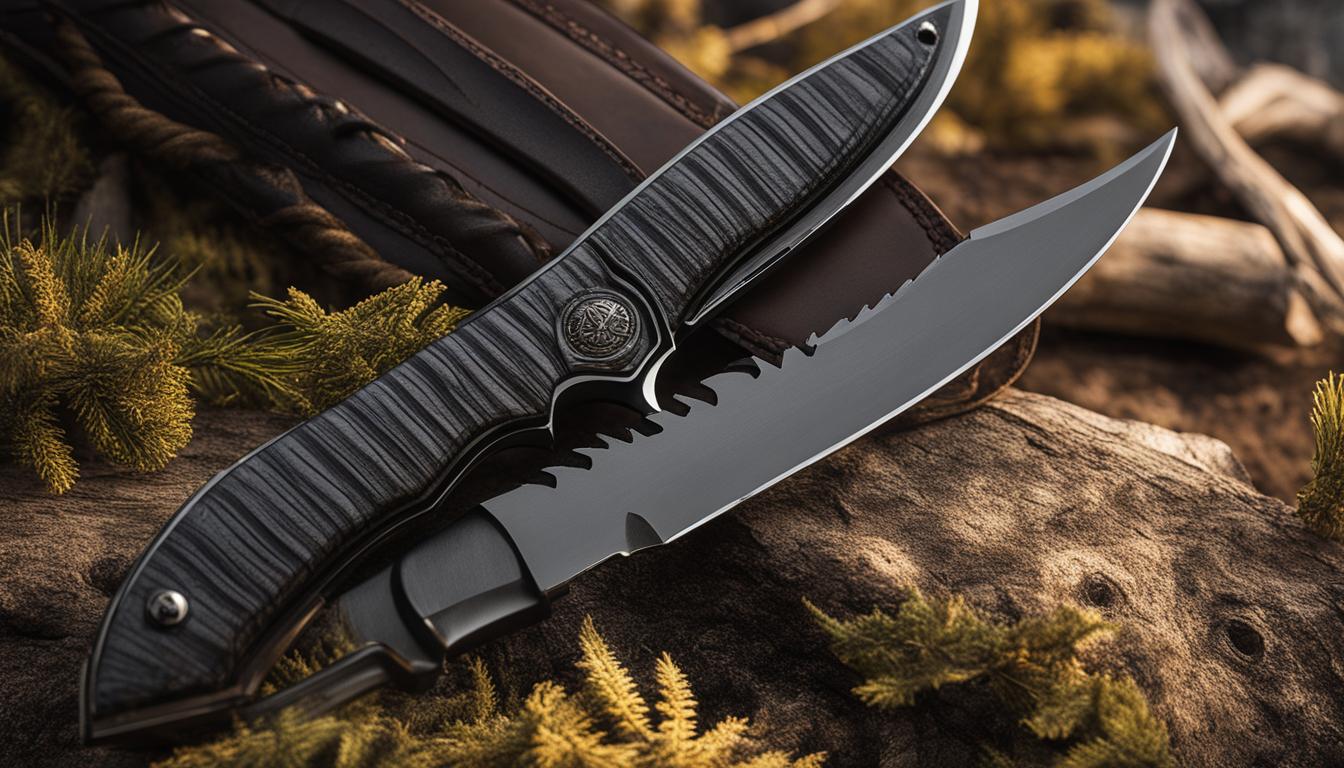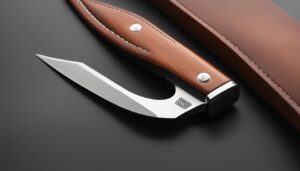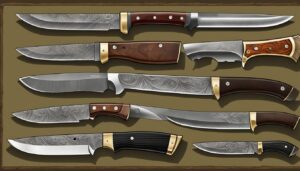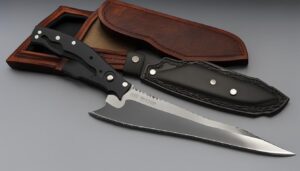Knives have been an integral part of human history for thousands of years and have evolved into essential tools for outdoor enthusiasts. The history of knives can be traced back to early humans who crafted stone and bone cutting tools. Over time, ancient civilizations like the Egyptians and Romans introduced metal blades, leading to the Industrial Revolution and the mass production of affordable knives. In modern times, hunting knives have seen advancements in materials, technology, and designs, making them versatile and reliable companions for outdoor activities.
Key Takeaways:
- Knives have a rich history and have evolved into essential tools for outdoor enthusiasts.
- Ancient civilizations like the Egyptians and Romans played a role in the evolution of hunting knives.
- Modern hunting knives showcase advancements in materials, technology, and designs.
- When choosing a hunting knife, factors such as intended use, blade length, handle comfort, weight, and balance should be considered.
- There are different types of hunting knives, including fixed-blade, folding-blade, and replaceable-blade knives, each with its own advantages and considerations.
Factors to Consider When Choosing a Hunting Knife
When it comes to selecting a hunting knife, there are several important factors that outdoor enthusiasts need to consider. The right hunting knife can greatly enhance your outdoor experiences and make tasks such as field dressing, skinning, and campsite chores much easier and efficient. So, what are the key factors to keep in mind when choosing a hunting knife? Let’s explore.
Intended Use
First and foremost, you need to determine the intended use of the hunting knife. Are you primarily a big game hunter, or do you engage in small game hunting? Will you be using the knife for survival purposes or as a multi-purpose tool? The intended use will dictate the type of knife you should choose. For example, a skinning knife with a curved blade is ideal for skinning game, while a drop point or clip point blade is versatile for various tasks.
Blade Length and Design
The blade length and design are crucial aspects to consider. Longer blades offer greater reach and are ideal for chopping and slicing tasks, making them suitable for larger game. On the other hand, shorter blades provide more control and precision, perfect for detailed work such as caping or intricate carving. The design of the blade, whether it’s a drop point, clip point, or gut hook, should align with your specific needs and hunting style.
Handle Comfort and Ergonomics
Another vital consideration is the handle comfort and ergonomics. Since you’ll be using the knife for extended periods, it’s important to choose a handle that feels comfortable in your hand and provides a secure grip. Look for handles made from materials such as rubber, G-10, or micarta, as these offer excellent grip and durability. Ergonomic designs with finger grooves or textured patterns can further enhance the knife’s handling and control.
Weight and Balance
The weight and balance of the hunting knife greatly influence its overall performance. A knife that is too heavy may cause fatigue during prolonged use, while one that is too light may lack the necessary heft for certain tasks. Balancing the weight between the blade and handle is also important for optimal control and maneuverability. Consider holding the knife in your hand to assess its weight and balance before making a decision.
Types of Hunting Knives: Fixed-Blade, Folding-Blade, and Replaceable-Blade
When it comes to hunting knives, there are three main types to consider: fixed-blade, folding-blade, and replaceable-blade knives. Each type has its own unique features and advantages, catering to different preferences and needs of hunters and outdoor enthusiasts.
Fixed-blade knives are known for their strength and durability. They have a solid, non-folding blade that is permanently attached to the handle. These knives offer excellent balance and control, making them ideal for heavy-duty tasks like field dressing and skinning game. They are also easier to clean and maintain, as there are no moving parts to worry about.
Folding-blade knives, also known as pocket knives, are versatile and compact. They feature a blade that can be folded into the handle, making them easy to carry and store. Folding knives often have additional tools or features, such as saws, gut hooks, or bottle openers, making them handy for various outdoor tasks. While not as robust as fixed-blade knives, folding knives are convenient for everyday use and are suitable for light to medium-duty hunting and outdoor activities.
Replaceable-blade knives offer the advantage of easy blade replacements in the field. These knives typically have a handle that holds disposable blades, allowing hunters to quickly change blades when they become dull or damaged. This eliminates the need for sharpening and ensures a consistently sharp cutting edge. Replaceable-blade knives are popular among hunters who prioritize convenience and prefer a razor-sharp blade at all times.
Comparison of Hunting Knife Types
| Type | Advantages | Considerations |
|---|---|---|
| Fixed-Blade | Strong and durable, excellent control, easy to clean | Bulkier to carry, requires a sheath for protection |
| Folding-Blade | Versatile, compact, additional tools or features | Less robust, potential for blade play or lock failure |
| Replaceable-Blade | Quick and easy blade replacements, consistently sharp edge | Blade replacements needed, may be less sturdy |
When choosing a hunting knife, it’s important to consider your specific needs and preferences. Fixed-blade knives are reliable and strong, folding-blade knives offer versatility and convenience, while replaceable-blade knives provide on-the-spot sharpness. Ultimately, the decision comes down to personal preference, intended use, and the demands of your outdoor activities.
Blade Size, Materials, and Grinding Methods
When it comes to hunting knives, the size of the blade plays a crucial role in determining its usability and effectiveness. While oversized knives may seem impressive, a smaller, well-shaped blade often offers more control and efficiency. It allows for precise cutting and maneuverability, making it ideal for intricate tasks such as skinning and field dressing. Additionally, a smaller blade is easier to carry and handle in the field.
The choice of materials for hunting knife blades is equally important. Steel and stainless steel are widely used for their durability, hardness, and resistance to corrosion. Different alloys and compositions offer unique properties and performance characteristics. For example, high carbon steel blades are known for their exceptional sharpness and edge retention, while stainless steel blades are easier to maintain and less prone to rust. When selecting a hunting knife, consider the intended use and the specific qualities offered by different blade materials.
The grinding method employed on the blade also affects its cutting performance. Two common types of blade grinds are the flat grind and the hollow grind. The flat grind, characterized by a single bevel that extends from the spine to the cutting edge, offers excellent durability and strength. It is well-suited for heavy-duty tasks such as chopping and batoning. On the other hand, the hollow grind features a concave shape that creates a razor-sharp edge. It excels in precision cutting and slicing tasks. Understanding the various blade grinding methods can help you choose a hunting knife that meets your specific cutting needs.
| Blade Size | Blade Materials | Grinding Methods |
|---|---|---|
| Smaller, well-shaped blade offers more control and efficiency | Steel and stainless steel provide durability, hardness, and resistance to corrosion | Flat grind offers durability and strength, hollow grind provides a razor-sharp edge |
By considering factors such as blade size, materials, and grinding methods, you can make a well-informed decision when choosing a hunting knife. Remember to prioritize your specific needs and preferences, as different blade characteristics excel in different hunting situations. Whether you need a knife for precision cutting or heavy-duty tasks, the right hunting knife can enhance your outdoor experience and be a reliable companion in the wild.
Examples of Good Hunting Knives for Different Uses
When it comes to choosing a hunting knife, finding one that suits your specific needs is crucial. There are numerous options available, each with its own advantages and features. Whether you’re a seasoned hunter or a beginner, having a versatile and reliable hunting knife can make all the difference in your outdoor adventures. Here, I will showcase some examples of good hunting knives that excel in different uses, ensuring you find the perfect tool for your needs.
Fixed-Blade Hunting Knives
Fixed-blade hunting knives are known for their durability and strength. They offer excellent control and versatility, making them ideal for various outdoor tasks. One example of a good fixed-blade hunting knife is the Victorinox Master Mic L. With its drop point design and high-strength alloy blade, this knife provides exceptional durability and versatility. Whether you’re field dressing game or performing other intricate tasks, the Master Mic L is up to the challenge.
Folding-Blade Hunting Knives
If you prefer a hunting knife that offers convenience and ease of carry, a folding-blade knife is a great choice. The Victorinox Swiss Army Folding Hunter is an excellent example of a versatile folding-blade hunting knife. It features a stainless steel blade and an ergonomic grip, ensuring a comfortable and secure hold. This knife is perfect for everyday carry and excels in a variety of outdoor tasks.
Replaceable-Blade Hunting Knives
For those who prefer the convenience of quick and easy blade changes in the field, replaceable-blade hunting knives are the way to go. The Outdoor Edge RazorMax is a standout example of a reliable and practical replaceable-blade hunting knife. With its innovative design, this knife allows you to swap out blades effortlessly, ensuring a sharp cutting edge at all times. Whether you’re skinning game or performing other heavy-duty tasks, the RazorMax is a versatile and reliable companion.
As you can see, there are plenty of good hunting knives available for different uses. Whether you choose a fixed-blade, folding-blade, or replaceable-blade knife, selecting a high-quality and versatile tool is essential. Consider your specific needs and preferences, and choose a hunting knife that will help you tackle any outdoor challenge with confidence.
| Hunting Knife | Type | Features |
|---|---|---|
| Victorinox Master Mic L | Fixed-Blade | Drop point design, high-strength alloy blade |
| Victorinox Swiss Army Folding Hunter | Folding-Blade | Stainless steel blade, ergonomic grip |
| Outdoor Edge RazorMax | Replaceable-Blade | Quick and easy blade changes, durable construction |
Note: The table above provides a quick summary of the featured hunting knives.

Conclusion: The Timeless Importance of Hunting Knives for Outdoor Enthusiasts
Hunting knives hold a special place in the hearts of outdoor enthusiasts, serving as reliable companions throughout their expeditions. These indispensable tools have a long and storied history, evolving from simple cutting implements to the advanced designs and materials we see today.
As an outdoor enthusiast myself, I understand the innumerable benefits a high-quality hunting knife can bring. Whether you’re camping, hunting, fishing, or simply exploring the great outdoors, a well-chosen hunting knife becomes an extension of your hand, enabling various tasks with precision and ease.
When selecting a hunting knife, it’s important to consider factors such as the intended use, blade length, handle comfort, weight, and balance. These aspects ensure that your knife is tailored to your specific needs and preferences, allowing you to tackle any challenge that comes your way.
For the adventurous souls among us, hunting knives are more than mere tools; they are an essential part of our outdoor journeys. With the right hunting knife by your side, you can confidently navigate the wilderness, overcome obstacles, and embrace the thrill of the unknown.
FAQ
What is the history of hunting knives?
Hunting knives have been used by humans for thousands of years and have evolved from stone and bone tools to metal blades introduced by ancient civilizations. The Industrial Revolution led to mass production, making knives more affordable and readily available.
What factors should I consider when choosing a hunting knife?
Factors to consider include the intended use, blade length, handle comfort and grip, weight and balance, and the thickness of the blade for different tasks.
What are the main types of hunting knives?
The three main types of hunting knives are fixed-blade, folding-blade, and replaceable-blade. Each type has its own advantages and considerations, depending on personal preferences and specific needs.
What is the importance of blade size and material in hunting knives?
Blade size should be chosen based on the intended use, and smaller, well-shaped blades often offer more control and efficiency. Steel and stainless steel are common choices for their hardness, durability, and corrosion resistance.
What are the different blade grinding methods and their advantages?
The two common blade grinds are flat-grind and hollow-grind. Flat-grind offers durability and strength, while hollow-grind provides a sharper cutting edge for precision tasks.
Can you provide examples of good hunting knives for different uses?
Examples include the Victorinox Master Mic L for durability and versatility, the Victorinox Swiss Army Folding Hunter for strength and ease of carry, and the Outdoor Edge RazorMax for quick and easy blade changes in the field.
Why are hunting knives important for outdoor enthusiasts?
Hunting knives have a long history and have evolved into essential tools for outdoor enthusiasts. They serve various purposes and are reliable companions for outdoor activities, providing the necessary cutting tools for various tasks.





